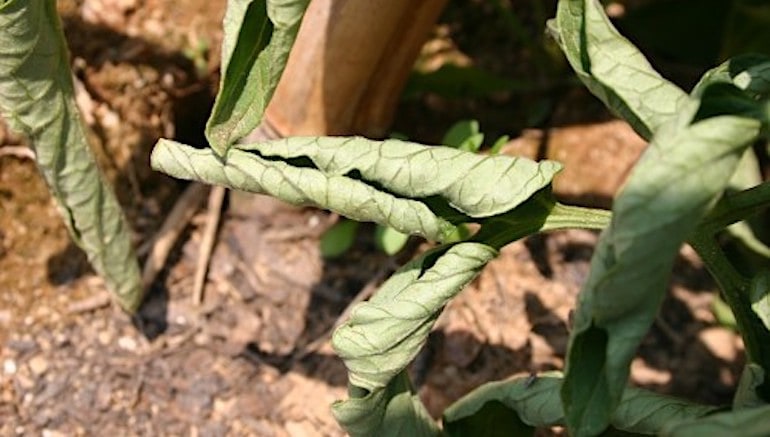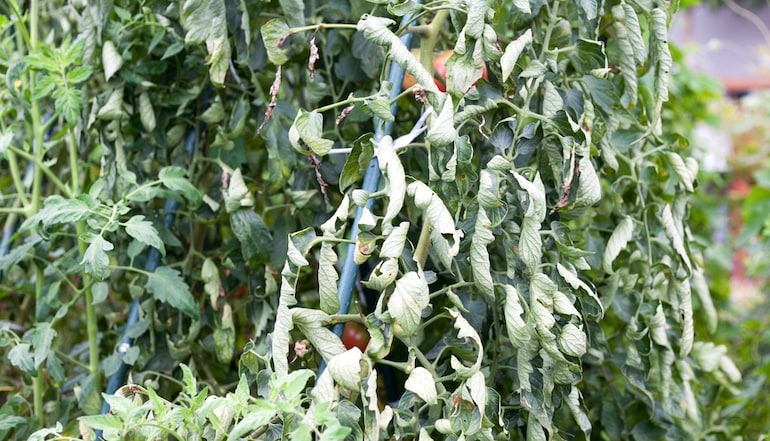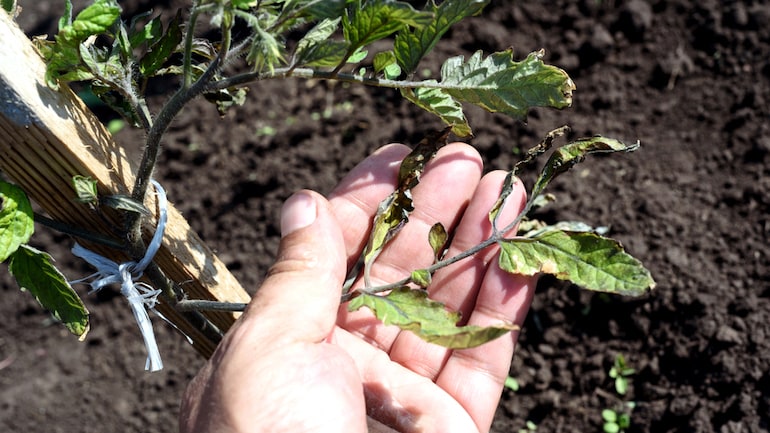Garden diseases - Tomato leaf curl

Tomato leaf curl is a common affliction of stressed plants
Image: Walter Reeves
Leaf curl is a common problem affecting tomato plants, but often the cause is physiological rather than infectious or pest-related. Tomatoes are easy to grow but they’re more delicate than some gardeners realise. Inadequate watering, over-watering, unstable temperatures, and hormone weed killers are among the main causes of leaf curl.
Here we take a look at some of the reasons why your tomato leaves don’t look quite as lush and healthy as you’d like.
What is tomato leaf curl?

Leaf curl can look more damaging than it actually is
Image: Miyuki Satake
It’s rather alarming, when you check your tomatoes, to find the leaves of your prize vines curled and twisted. As long as the plant is otherwise healthy, there’s no reason to despair. By modifying the growing environment, it’s perfectly possible to undo the damage and achieve great harvests.
What causes tomato leaf curl?

Simple environmental factors such as strong winds can cause leaf curl
Image: John Williams RUS
What has the weather been like lately? If your tomato leaves are showing signs of stress, this could be because of:
- Windy weather. Tomatoes don’t like the wind, particularly when the weather’s dry. Blustery conditions can damage the outer edges of leaves, causing them to curl. If your plants are adversely affected by the wind, consider erecting a screen – willow hurdles are a good temporary solution.
- Dry weather/under-watering. During hot, dry weather, tomato leaves may curl as the plants strive to conserve water. Regular irrigation can solve this problem, and for greenhouse tomatoes, judicious use of blinds or white window paint can prevent the sun scorching your tomatoes.
- Over-watering. Overdoing your watering can have a similar effect to underwatering. You may also find your plants produce an excess of foliage but few tomatoes. Leaves might yellow and wither, or they could curl. Tomatoes like humid conditions, but they don’t like being soaked. Check for signs of oedema – lumps and nodules on leaves and stems – a sure sign you’re over-watering, and reduce as necessary.
- Too cold. Tomatoes don’t like it when temperatures dip below 12C. If that’s the case, the plants can’t process the carbohydrates they’ve produced during the day, and the leaves may curl. While temperature variation is often a problem during the warm days and chilly evenings we experience during the spring, conditions improve as we move into the summer. If the weather is extreme, you could cover your plants with fleece during the night time, but otherwise, this is a problem which normally resolves without permanently affecting leaves or harvests.
If your tomatoes do enjoy optimal growing conditions, but the leaves are still curling, there are a couple of other factors that could be causing the problem.
- Mineral deficiency. A good tomato fertiliser should mean that your plants get all the nutrients they need, but if there is a deficiency, it could manifest in the form of curled or mottled leaves. Mottling usually denotes a magnesium deficiency, but if it’s only affecting the old leaves, this isn’t a cause for concern.
- Hormone weedkillers. Tomatoes are very susceptible to hormone weedkillers – even wind-born residues can have a deleterious effect on them. Be very careful to store your weed killers well away from tomato plants, especially during warm weather when even the presence of a bottle of herbicide in the greenhouse could damage your tomatoes.
As long as your tomato vines are in otherwise good condition, a bit of leaf curl is unlikely to cause a poor harvest. If you buy good quality, strong tomato plants from reputable nurseries, optimise growing conditions and get your feeding regime right you can prevent or manage leaf curl and assure a bumper harvest.
Other pages you might like
See all pests & diseases guides
Individual guides
Diseases
- Apple scab
- Bacterial canker
- Blackleg
- Blossom wilt
- Botrytis
- Brown rot
- Clematis wilt
- Downy mildew
- Fungal disease
- Honey fungus
- Leaf scorch
- Leaf spot
- Leek rust
- Lily disease
- Peach leaf curl
- Pear rust
- Phytophthora root rot
- Potato & tomato blight
- Powdery mildew
- Silver leaf fungus
- Tomato greenback
- Tomato stem canker







